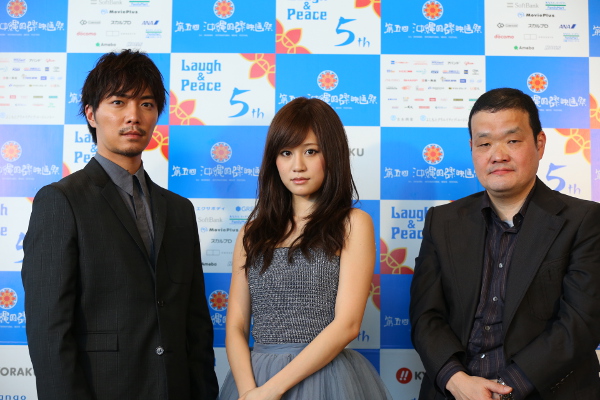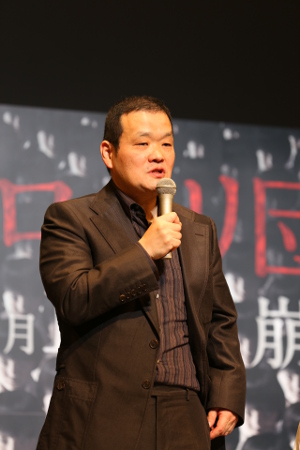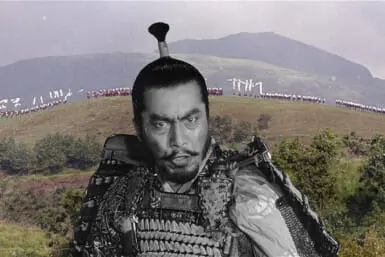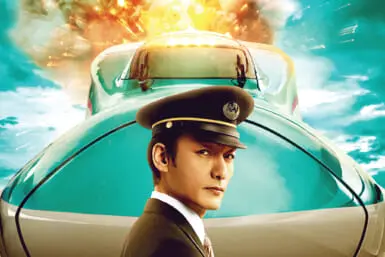Above – director Hideo Nakata (right) with the stars of The Complex, Atsuko Maeda and Hiroki Narimiya: (© 2013 Okinawa International Movie Festival / Yoshimoto Laugh & Peace)
Despite branching out into different fields in recent years, director Hideo Nakata’s name will forever be synonymous with the Horror genre in which he made his name. When his classic work ‘Ring’ was released in 1998, it kick started a boom in Japanese horror movies, bringing other Japanese films to international attention and resulting in certain key works being remade by Hollywood.
In addition to ‘Ring’ and its sequel, Nakata made the chillingly atmospheric ghost story ‘Dark Water’ which concerned the haunting of an apartment building by the ghost of a child unable to rest. With his new film ‘The Complex’ (Japanese title, Kuruyori Danchi) the director is back on familiar ground as former AKB48 golden girl Atsuko Maeda stars as a young woman who moves into a new building only to be troubled by mysterious noises coming from the apartment next door, and in typical Hideo Nakata fashion a ghostly young child also makes its presence felt.
The film premiered at last month’s Okinawa International Movie Festival where our writer Christopher O’Keeffe was able to sit down with Nakata and discuss his latest film and past work.
Christopher O’Keeffe (COK): Congratulations on your film. You spearheaded a movement with J-horror in the nineties but I think it was the last time that Japanese movies had a strong presence worldwide, a movement. What do you think of the Japanese movie industry now? Where do you think it is heading?
Hideo Nakata: Regarding the J-horror wave, it is definitely not active anymore especially in terms of the remaking of Asian horror in America. I can’t speak for the Japanese horror film industry as a whole but because we were suffering in a recession after the Lehman brothers shock, I have to say that the average budget of the Japanese live action film has been going down.
It seems like there is a small light coming down in terms of the Japanese economy but in terms of the film industry itself we cannot be optimistic about making big action films. It’s a negative factor that even the biggest film company, Toho, is struggling.
I heard that the president of Toho said we have to minimise budgets so that we can avoid sheer failure of the business, but at the same time because of the development of digital technology we can make films much cheaper. That is the other side of the coin, the younger directors can make their movies based on their own ideas with a much less expensive budget.
COK: In terms of creativity, what do you see in the new generation filmmakers? Can you find hope in them?
Nakata: Because I now live in the suburbs I don’t see so many contemporary films, its impossible, but it seems that there aren’t so many big hits in the box office. There aren’t so many influential film critics any more but even they like some films and endorse those films but actually the numbers at the box office show that there aren’t so many films that can actually make money with just a theatrical release and DVD sales have actually have been going down. I’m not saying its disastrous, but it is shrinking.
COK: When you were making your early horror films, were you aware that you had an international audience? Did you think that they would break out of Japan?
Nakata: No, when I was first hired to make ‘Ringu’ I hadn’t made a horror film for a big budget, and ‘Ringu’ was still just a $1.2 million film. I knew it was going to be released nationwide but still at that time the genre film was considered to be straight to video so we didn’t expect to much.
‘Ringu’ and ‘The Spiral’ (the 1999 Fuji television series) were released at the same time but were censored so the number of releases was going to be very limited, but Toho decided to increase the number from 72 to 150, which made me really nervous! I just hoped that the film would recoup money for the investors.
COK: You made your name in horror and you’ve come back to it now, what makes you continually return to this genre?
Nakata: Actually when I came back to Japan after making ‘Ring 2’ in America, I made one ghost story, a costume play, called ‘Kaidan’, which was not that popular in Japan or in foreign countries, but it was actually a horror film. In my mind it’s not ‘coming back’ when I decided to make ‘The Complex’, but yes if you really classify it like that then ‘Kaidan’ is half ghost story half love story. That was released in 2005 so it has been eight years.
I don’t look upon myself as a genre director – it’s up to the people or the industry people if they think I’m good at making horror films but I make documentaries, (such as) ‘Life after 3/11’ and thrillers, such as ‘The Incite Mill’; that’s not as violent as ‘Saw’ but it’s a killing game thriller…
COK: So you don’t have a specific desire to make horror?
Nakata: No, in my mind its not really a coming back because I have been dealing with the protagonist’s fear and anxiety even in ‘Chatroom’ or ‘The Insight Mill’; they are not considered to be strictly horror films but are strongly connected to that genre.
COK: I did think this was different because it was more about the girl’s internal feelings and the external horror was her way of dealing with it, so it was different to the traditional ghost story.
You mentioned ‘Kwaidan’, I’m a big fan of the original Kobayashi version, yours is a different story to that…
Nakata: Yes, very different, his version is based upon Lafcadio Hearn‘s story, mine is based upon a rakugo play called Shinkeikasanegifuchi, by Sanyutei Enchou. It’s a long, long ghost story and the performer really was a genius, a Mozart in the rakugo field.
He lived from the end of the Edo period to the beginning of the Meiji era and was truly a master, a genius to create it. Actually he improvised when he was talking, he played eight nights in a row. Our story was based on the original rakugo and I think it has been made four times into a film. Our challenge was to include everything, it is a very long story, and has very complicated relationships so it is a tough story to tackle and make into a two hour film and, like I said, its half love story and half ghost story.
COK: With The Complex, did you choose Atsuko Maeda for the leading role yourself?
Nakata: Yes in a way but the producer, Yasushiaki Yashimoto, strongly recommended her. He said ‘Nakata-san, if you are on board then she should be the one to play the protagonist’. When I said yes to his offer he decided to make an offer to her because she really wanted to be an actress, especially in a feature film, after ‘graduating’ from AKB48.
COK: Did you have any reservations about her as an actress, any doubts?
Nakata: Not really. I haven’t seen so many of her performances, but I watched one film and, you know, I understood her career as an actress was not that rich in numbers etc. But when I met her I asked her to expose herself as a 20-year-old girl, not as a top idol singer but as an ordinary, sensitive, fragile girl. I thought as a person she had that kind of quality, and I said ‘please expose yourself and play in this kind of role which cannot be played by other girls; it should be played just by you’.
COK: So did you challenge her in any way? Did you feel you had to push her to get the performance?
Nakata: Not really, yes we rehearsed and exchanged some ideas, but you know because she has been singing and dancing and was a top idol for many years, she has the star quality.
She has been watched by so many eyes in the music and TV industry. She has been watching so many movies, including Hollywood classics, and so that kind of star quality and her effort and desire to step up as a film actress has had a positive impact on her performance in The Complex. In general, Japanese actors’ performances are better in earlier takes, but, probably because she was and is still a singer, she patient with directorial comments and she got better with five or seven takes.
COK: As a director do you usually do lots of takes?
Nakata: You know I recognise that they (the actors) said several times (at a joint press conference) to me today that we did a lot of takes. Well for me its normal, but for them its not normal to take five takes. For me it’s very normal.
COK: Where they suggesting thats its unusual?
Nakata: Probably. The way I edit on camera, I shoot bits and pieces: thats the traditional Japanese way. I can’t shoot the film in Japan, in the Hollywood style, nor in the UK style. In Japan, how to edit the scene is already in my mind when I shoot it.
Younger directors probably are more likely to introduce the Hollywood style: they shoot coverage, the master-shot, and different coverages and that makes them run quicker with one angle because they go to different angles many times.
COK: One stylistic point of the film I’d like to talk about, I noticed there was a water motif throughout the film. Whenever they were in the doorway, there was a water rippling effect…
Nakata: Well thats the DP (Director of Photography), Hayashi-san, with whom I have been working since ‘Ringu’. Most of my horror films and feature films are shot by him.
In Japan we have different systems technician wise, the DP, lighting directors and first assistant camera men. These three people are the ones to set up the shot and in order to create the feeling of the climax, when the real ghost is about to come in, we should try something new, something experimental. I actually suggested as a reference Edvard Munch’s ‘The Scream’.
I suggested those wavy, very colourful movements from the sky in that painting, so the lighting director and DP decided to try that. (For one scene) the technician put water tanks in every room of the set and colour lighting and he just stirred it. The DP carefully graded the film in the climax scenes so that the watery effect wouldn’t look like a coral reef or a refreshing ocean scene…
COK: The climbing-frame in the playground too…
Nakata: Yes, that’s sort of my idea, but I have to confess Alfred Hitchcock has been my mentor so you can easily imagine ‘Vertigo’, James Stewart, that kind of nightmare, a Saul Bass image. The climbing frame was shot from a high angle and with digital technology we made it turn.
COK: In the future is there anything you would really like to make? Do you have a dream project in mind?
Nakata: If I choose just one film to take to a deserted island that would be ‘Letter From an Unknown Woman’. Its a Hollywood classic tear-jerker romance, I would definitely like to make that kind of film.
COK: Do you think you could make that kind of movie in Japan?
Nakata: No, not now. Love and romance is not for the younger generation, younger Japanese people.
In our period it was not that easy to find the best boyfriend or girlfriend, but now it is not that difficult to find one. Now if you are split you are still connected by e-mails and so on, it’s so difficult to put some kind of either dilemma or conflict or war between the man or woman, when in the 70s or 80s it was easier. It could be an age difference or class difference but now people can easily be connected, and even a separated couple can be connected.
‘Letter from an unknown woman’ starts like this, ‘when you read this letter, I may be dead’. Thats a beautiful line. Actually a female Chinese director remade the film and it was shown when I was in Spain, but I didn’t want to watch it! But the original is a beautiful film, for me starring the best Hitchcock actress, Joan Fontaine. So I would make a love story, a love romance tear-jerker.










